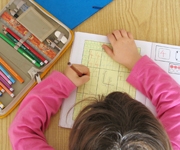 Learning to write – I can do it with my left hand! Advice for left-handed children
Learning to write – I can do it with my left hand! Advice for left-handed children
Left-handed children can write just as quickly, automatically and legibly as their right-handed counterparts – if the overall conditions are right.
Foto: Thommy Weiss / pixelio.de
 The percentage of children who write with their left hand is constantly increasing. In German-speaking primary schools it is already 15 to 25 percent (Vasterling et al., 2011). Left-handed children generally exhibit no difference in writing performance (Sattler & Marquardt, 2010). There are indicators, however, that sub-optimal writing conditions can lead to increased writing pressure and cramped body and pen posture. The following basic rules (Sattler 2007; 2015) help to prevent this:
The percentage of children who write with their left hand is constantly increasing. In German-speaking primary schools it is already 15 to 25 percent (Vasterling et al., 2011). Left-handed children generally exhibit no difference in writing performance (Sattler & Marquardt, 2010). There are indicators, however, that sub-optimal writing conditions can lead to increased writing pressure and cramped body and pen posture. The following basic rules (Sattler 2007; 2015) help to prevent this:
1. Ensure that the child is sitting next to another left-handed child or to the left of a right-handed child. This will ensure they don’t get in each other’s way while writing.
2. The light (desk lamp, window, etc.) should come from the right or in front.
3. The notebook should be angled 30° to 40° to the right. The upper right-hand corner should be positioned downward compared to the left.
4. The left hand rests below the line. A hook grip (hand above the line to prevent smudging) should be avoided. The right hand holds the page. It rests on the right-hand edge of the page, level with the line being written on. This means it is not in the way.
5. A relaxed pen hold is very important.
6. The child should assume a straight body posture. The feet rest firmly on the ground, the lower arm remains comfortably on the table.
7. The template letters on exercise sheets are normally only on the left, at the start of the line. As a result the child covers the letters they are trying to practice and has to be able to copy them. The child should copy the letter on the right-hand end of the line first, so that the letter is always visible.
8. Reminders help: the correct page position (30°-40°) can be stuck to the table with masking tape. Pictures showing best practice can be used for correct body, pen and hand posture.
9. Provide ergonomically favourable writing instruments, such as soft coloured and lead pencils, to counteracting increased writing pressure.
Further reading
SATTLER, J. B.; MARQUARDT, C.: Motorische Schreibleistung von linkshändigen und rechtshändigen Kindern in der 1. bis 4. Grundschulklasse. In: Ergotherapie und Rehabilitation 49 (2010), Ausgabe 1 und 2.
SATTLER, J. B.: Das linkshändige Kind - seine Begabungen und seine Schwierigkeiten (2015), Auer Verlag: Donauwörth.
VASTERLING, A.; WEILAND, G.; SATTLER, J. B.: Linke Hand - rechte Hand: Ein Ratgeber zur Händigkeit (2011), Schulz-Kirchner Verlag: Idstein.
SATTLER, J. B.: Das linkshändige Kind in der Grundschule (2007), Auer Verlag: Donauwörth.
The complete publications by the Schreibmotorik Institut
If you want to use information or contents of this article, please cite it as follows:
Schreibmotorik Institut e.V. (2017). Playful motor skills writing courses: Fun while writing, fun while learning. Retrieved [Month dd, yyyy] from http://www.schreibmotorik-institut.com/index.php/en/facts-tips/expertise/559-learning-to-write-i-can-do-it-with-my-left-hand-advice-for-left-handed-children

